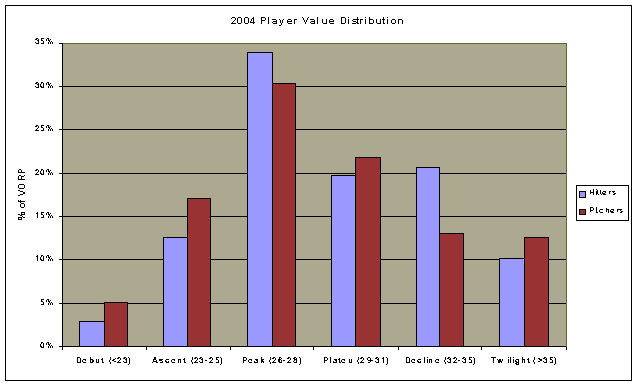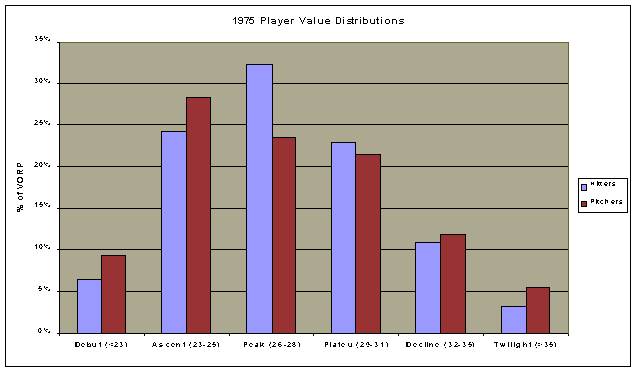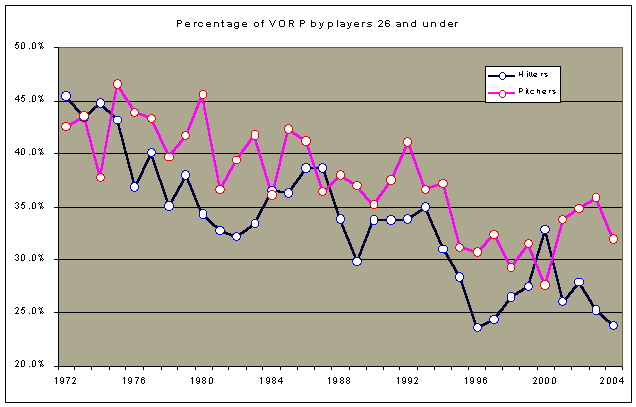BP Comment Quick Links

 | |
May 11, 2005 Lies, Damned LiesThe Graying of the Game
I'm not breaking any news here: Offense is down. Home runs are off some 13% from 2004, and 9% from the average levels over 2002-2004. Slugging percentage and run production are down accordingly. This has occurred over tens of thousands worth of plate appearances: five weeks of baseball might not be enough to come to any conclusions about the performances of individual players, but it's plenty enough to make some inferences about broader, league-wide trends. It doesn't accomplish anything to ignore the 500-pound gorilla in the room. It's entirely possible that this change is the result of baseball's harsher steroid policy. However, it's also worth remembering that offensive levels have often fluctuated wildly from season to season, usually with no apparent cause. Leonard Koppett, in his Concise History of Major League Baseball, became so frustrated with the whole fluctuation thing that he essentially just came to the conclusion that the ball was juiced for some seasons, and not in others, and that was that. Koppett didn't offer any proof of this per se, apart from the book's general message that baseball's history is full of incompetent and corrupt personalities, and it would not be beyond those sorts of personalities to do something like juice the baseball. In the absence of other explanations--why did offense shoot up so suddenly in 1987, and just as suddenly shoot back down?--Koppett found the juiced ball theory to be the path of least resistance. The point is not imply that the ball has been juiced or, in this case, de-juiced. (It would, however, make for one hell of a Machiavellian conspiracy story if evidence emerged that the ball had been altered: I had a high school English teacher who had the habit of giving each student a C+ on her first paper of the term, in order to prove how much he'd improved her writing when she'd inevitably end up with a stream of As to end the year). Rather, the point is that it's natural for someone--especially someone as smart as Koppett--to seek explanations where none might exist. Broad-scale offensive fluctuations are certainly not random; the sample sizes are much too large for that. That doesn't mean we'll always have a ready explanation for them. The steroid explanation makes good copy, and it might well be true, but there isn't any proof of it. With that long-winded caveat in mind, let's go ahead and play the blame game. If not steroids, well, what then? It's been my impression for a couple of years that there have been a disproportionate number of good, young pitchers coming into the game. Here, for example, are some of the talented pitchers who have made their major-league debuts in the last five seasons:
2000: Mark Buehrle, Mark Mulder, Johan Santana, Barry Zito Those names pretty much speak for themselves, though you can look at the pictures too if you like. Perhaps there are enough of these guys to have tipped the balance at least a little bit in favor of the pitchers? It's an interesting theory. Unfortunately, it isn't supported by the evidence. The following chart shows the cumulative percentage of VORP compiled by pitchers and hitters of various age groups in 2004 (players with negative VORPs are excluded from consideration):

Pitchers in the first two categories--aged 25 or younger--accounted for about 22% of leaguewide pitcher VORP in 2004. Indeed, this is a markedly higher figure than the comparable percentage for hitters of the same age group (about 15%). The problem is that the figure is not especially high in historical terms. Here, for example, is the same chart for the year 1975:

Thirty years ago or so, pitchers aged 25 and under accounted for about 38% total league pitching VORP. Young hitters were also contributing their fair share, accounting for 31% of total league offensive VORP. This points toward one of the most significant--and underreported--trends in modern baseball: the graying of the game. In 1975, the average major-league hitter was aged 27 years and four months. In 2004, 29 years and four months. In 1975, the average major-league pitcher was aged 27 years and seven months. In 2004, 28 years and eleven months. The aging curve, which has usually been assumed by analysts to be a stable, almost intransient thing, has shifted rather dramatically just within my lifetime. Here is another presentation of the same idea: this is the percentage of VORP accumulated by players aged 26 or younger for each year since 1972.

That isn't a subtle trend. In fact, this may fall into the category of things that are so obvious that nobody much seems to have noticed them. Let me talk about a few of the other noteworthy aspects of this data.
Of course, it could also be the other way around: the modern game rewards the three-run home run because the player population has aged. This is the sort of chicken-and-egg problem that I've talked about a lot in the past few weeks, and it doesn't have a neat resolution. All that having been said, the relative performances of pitchers and hitters have changed a little bit:
PERCENTAGE OF VORP BY PLAYERS 26 AND YOUNGER
Hitters Pitchers Gap
Pre Free Agency (1972-1976) 42.7% 42.9% 0.2%
Late Pre-Exhuberant Era (1988-1992) 33.0% 37.8% 4.8%
Early Exhuberant Era (1994-1998) 27.0% 32.4% 5.4%
Last Three Years (2002-2004) 25.7% 34.2% 8.5%
Both pitchers and hitters have aged significantly over the past 30 years. At the same time, hitters have aged somewhat more than pitchers have. The trend is particularly apparent over the past three or four seasons.
So it might not be the case that offense is declining because a lot of talented young pitchers are coming into the league. But a close corollary of this theory might be true: offense is declining because a lot of talented older hitters are exiting the league, or at least exiting the productive portions of their careers. Consider for a moment the league leaders in VORP in 1993, the last year before the dawn of what I'm calling the Exuberant Era:
Barry Bonds Age 28 This is a tremendously talented group of hitters, and also a tremendously young group of hitters--just Dykstra and Molitor buck the trend. Ron Gardenhire isn't really correct when he half-seriously attributes the decline in home runs to the absence of Barry Bonds--one player just doesn't make all that much difference in a sport like baseball. But if you combine the absence of Bonds with the collapse of Jim Thome, the ineptitude of Bernie Williams, the complete cratering of Jeff Bagwell and Rafael Palmeiro...well, that begins to add up. A lot of the hitters that were fueling the production of the Exuberant Era are no longer doing so. Perhaps that has something to do with Father Androsterone, but it has mostly to do with Mother Nature.
Nate Silver is an author of Baseball Prospectus.
|